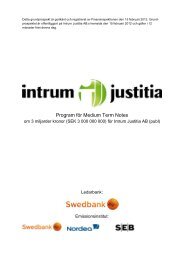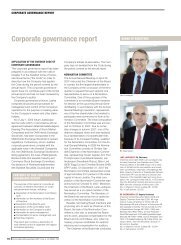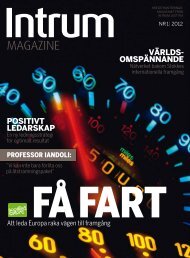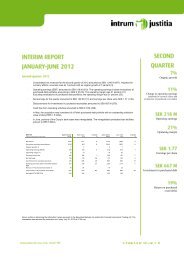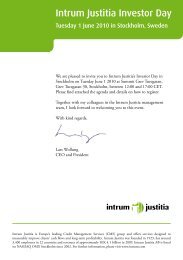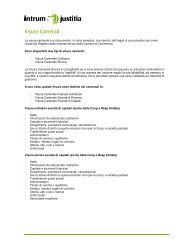ANNUAL REPORT INTRUM JUSTITIA A N N U A L R EP O R T 2 0 ...
ANNUAL REPORT INTRUM JUSTITIA A N N U A L R EP O R T 2 0 ...
ANNUAL REPORT INTRUM JUSTITIA A N N U A L R EP O R T 2 0 ...
Create successful ePaper yourself
Turn your PDF publications into a flip-book with our unique Google optimized e-Paper software.
56<br />
Notes<br />
term so that each reporting period is charged<br />
with an amount corresponding to a fixed interest<br />
rate for the liability recognized in each period.<br />
Variable fees are expensed in the period in<br />
which they arise.<br />
In operating leasing, lease payments are expensed<br />
over the lease term. Payments are recognized<br />
through profit or loss on a straight-line<br />
basis over the lease term. Benefits received in<br />
connection with the signing of an operating<br />
lease are recognized as part of the total lease expense<br />
through profit or loss.<br />
Taxes<br />
The Group applies IAS 12 Income Taxes.<br />
Income taxes consist of current tax and deferred<br />
tax. Income taxes are recognized through profit or<br />
loss unless the underlying transaction is recognized<br />
directly in total comprehensive income, in<br />
which case the related tax effect is also recognized<br />
in total comprehensive income. Current tax is the<br />
tax paid or received for the current year, applying<br />
the tax rates that apply as of the balance sheet date,<br />
including adjustments for current tax attributable<br />
to previous periods.<br />
Deferred tax is calculated according to the balance<br />
sheet method based on temporary differences<br />
between the carrying value of assets and liabilities<br />
and their value for tax purposes. The following<br />
temporary differences are not taken into account:<br />
temporary differences that arise in the initial reporting<br />
of goodwill, the initial reporting of assets<br />
and liabilities in a transaction other than a business<br />
combination and which, at the time of the<br />
transaction, do not affect either the recognized or<br />
taxable result, or temporary differences attributable<br />
to participations in subsidiaries and associated<br />
companies that are not expected to be reversed<br />
within the foreseeable future. The valuation of<br />
deferred tax is based on how the carrying values<br />
of assets or liabilities are expected to be realized or<br />
settled. Deferred tax is calculated by applying the<br />
tax rates and tax rules that have been set or essentially<br />
are set as of the balance sheet date.<br />
Deferred tax assets from deductible temporary<br />
differences and tax loss carryforwards are only recognized<br />
if it is likely they will be utilized within the<br />
foreseeable future. The value of deferred tax assets<br />
is reduced when it is no longer considered likely<br />
they can be utilized.<br />
Equity<br />
Share repurchases and transaction expenses are<br />
recognized directly against equity. Dividends<br />
are recognized as a liability after they are approved<br />
by the Annual General Meeting.<br />
Provisions<br />
The Group applies IAS 37 Provisions, Contingent<br />
Liabilities and Contingent Assets.<br />
A provision is recognized in the balance sheet<br />
when the Group has a legal or informal obligation<br />
owing to an event that has occurred and it is<br />
likely that an outflow of economic resources will<br />
be required to settle the obligation and a reliable<br />
estimate of the amount can be made. Where it is<br />
important when in time payment will be made,<br />
provisions are estimated by discounting the forecast<br />
future cash flow at a pretax interest rate that<br />
reflects current market estimates of the time value<br />
of money and, where appropriate, the risks associated<br />
with the liability.<br />
A provision for restructuring is recognized<br />
when a detailed, formal restructuring plan has<br />
been established and the restructuring has either<br />
begun or been publicly announced. No provision<br />
is made for future operating losses.<br />
A provision for termination costs is recognized<br />
only if the persons in question have known or presumed<br />
to have expected to be terminated by the<br />
balance sheet date.<br />
A provision for a loss contract is recognized<br />
when anticipated benefits that the Group expects<br />
to receive from a contract are less than the unavoidable<br />
costs to fulfill the obligations as set out<br />
in the contract.<br />
A provision for dilapidation agreements on<br />
leased premises is recognized if there is a contractual<br />
obligation to the landlord, within the foreseeable<br />
future, to restore the premises to a certain<br />
condition when the lease expires.<br />
Unidentified receipts and excess payments<br />
The Group receives large volumes of payments<br />
from debtors for itself and its clients. There are instances<br />
where the sender’s reference information is<br />
missing or incorrect, which makes it difficult to allocate<br />
the payment to the right case. There are also<br />
situations where payments are received on closed<br />
cases. In such instances a reasonable search and attempt<br />
is made to contact the payment sender, but<br />
failing this the payment is recognized as income<br />
after a certain interval. A provision is recognized in<br />
the balance sheet corresponding to the anticipated<br />
repayments of incorrectly received payments on a<br />
probability analysis.<br />
Contingent liabilities<br />
A contingent liability is recognized when there is<br />
a possible obligation that arises from past events<br />
and whose existence will be confirmed only by one<br />
or more uncertain future events or when there is<br />
an obligation that is not recognized as a liability<br />
or provision because it is not probable that an outflow<br />
of resources will be required.<br />
Impairment<br />
The Group applies IAS 36 Impairment of Assets.<br />
The carrying value of the Group’s assets, with<br />
certain exceptions, is tested on each balance sheet<br />
date for any indication of impairment. IAS 36 is<br />
applied to impairment testing of all assets with the<br />
exception of financial assets, which are valued according<br />
to IAS 39, investment assets for pension<br />
liabilities, which are valued according to IAS 19<br />
Employee Benefits, and tax assets, which are valued<br />
according to IAS 12.<br />
If there is any indication of impairment, the<br />
asset’s recoverable value is estimated. For goodwill<br />
and other intangible assets with an indeterminate<br />
period of use and intangible assets not yet ready for<br />
use, recoverable values are calculated annually. If<br />
essentially independent cash flows cannot be isolated<br />
for individual assets, the assets are grouped<br />
at the lowest level where essentially independent<br />
cash flows can be identified, i.e., a cash-generating<br />
unit. Intrum Justitia’s operations in each country<br />
or group of countries are considered the Group’s<br />
cash-generating units in this regard.<br />
An impairment loss is recognized when the<br />
carrying value of an asset or cash-generating unit<br />
exceeds its recoverable value. Impairment losses are<br />
recognized through profit or loss. Impairment losses<br />
attributable to a cash-generating unit are mainly<br />
allocated to goodwill, after which they are divided<br />
proportionately among other assets in the unit.<br />
The recoverable amount of cash-generating<br />
units is the higher of their fair value less costs to<br />
sell and value in use. Value in use is measured by<br />
discounting future cash flows using a discounting<br />
factor that takes into account the risk-free rate of interest<br />
and the risk associated with the specific asset.<br />
Impairment of goodwill is not reversed. Impairment<br />
of other assets is reversed if a change has been<br />
made in the assumptions that served as the basis<br />
for determining the recoverable amount. Impairment<br />
is reversed only to the extent the carrying<br />
value of the assets following the reversal does not<br />
exceed the carrying value that the asset would have<br />
had if the impairment had not been recognized.<br />
Employee benefits<br />
The Group applies IAS 19 Employee Benefits,<br />
IFRS 2 Share-based Payment and statement UFR<br />
7 IFRS 2 and social security contributions for<br />
listed enterprises from the Swedish Financial Reporting<br />
Board.<br />
Pension obligations<br />
The Group’s pension obligations are, for the most<br />
part, secured through official pension arrangements<br />
or insurance solutions. Pension obligations<br />
vary between countries on the basis of legislation<br />
and different pension systems. See also Note 23 for<br />
a further description.<br />
Defined contribution pension plans are plans<br />
where the company’s obligation is limited to the<br />
fees it has committed to pay. The size of the employee’s<br />
pension depends in part on the fees the<br />
company pays to an insurance company and in<br />
part on the return generated and actuarial factors.<br />
Consequently, it is the employee who assumes the<br />
investment risk and actuarial risk. The company’s<br />
obligations for defined contribution pension plans<br />
are expensed through profit and loss as they are<br />
vested by employees who render services on behalf<br />
of the company.<br />
For defined benefit pension plans, the pension<br />
obligation does not cease until the agreed pensions<br />
have been paid. The Group’s net obligation for defined<br />
benefit pension plans is calculated separately<br />
for each plan by estimating future compensation<br />
the employees has earned in current and previous<br />
periods; this compensation is discounted present<br />
value. The calculation is performed by an actuary<br />
using the so-called Projected Unit Credit Method.<br />
The fair value of Intrum Justitia’s share of any investment<br />
assets as of the balance sheet date is calculated<br />
as well.<br />
Actuarial gains and losses may arise in the determination<br />
of the present value of the obligation<br />
and the fair value of investment assets. They arise<br />
either because the actual outcome deviates from<br />
previous assumptions or the assumptions change.<br />
Intrum Justitia applies a corridor rule, which<br />
means that the portion of the accumulated actuarial<br />
gains and losses exceeding ten percent of the<br />
higher of the commitments’ present value and the<br />
fair value of assets under management is recognized<br />
over the anticipated average remaining pe-




